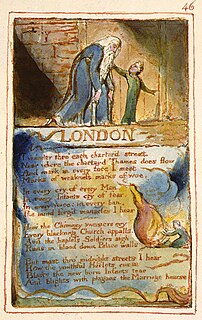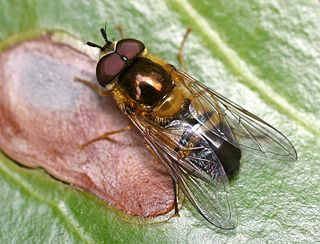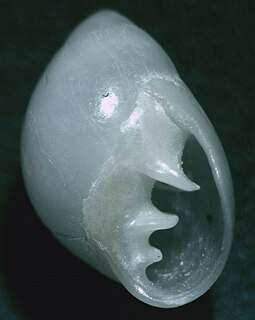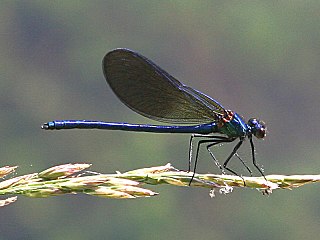
The Piophilidae are a family of "true flies", in the order Diptera. The so-called cheese flies are the best-known members, but most species of the Piophilidae are scavengers in animal products, carrion, and fungi. They may accordingly be important in forensic entomology and medical entomology. For a fly maggot, the larvae of many species have an unusually well-developed ability to leap when alarmed or when abandoning their larval food to pupate; they accordingly may be known as cheese skippers or other kinds of skippers according to their food source.

Convolvulaceae, known commonly as the bindweed or morning glory family, is a family of about 60 genera and more than 1,650 species of mostly herbaceous vines, but also trees, shrubs and herbs, and also including the sweet potato and a few other food tubers.

In rhetoric, an anaphora is a rhetorical device that consists of repeating a sequence of words at the beginnings of neighboring clauses, thereby lending them emphasis. In contrast, an epistrophe is repeating words at the clauses' ends. The combination of anaphora and epistrophe results in symploce.
Epistrophe is the repetition of the same word or words at the end of successive phrases, clauses or sentences. It is also known as epiphora and occasionally as antistrophe. It is a figure of speech and the counterpart of anaphora. It is an extremely emphatic device because of the emphasis placed on the last word in a phrase or sentence.
Empyelocera xanthostoma is a species of ulidiid or picture-winged fly in the genus Empyelocera of the family Tephritidae.

Epistrophe is a genus of flies in the family Syrphidae, the hoverflies or flower flies.

Marinula is a genus of small air-breathing land snails, terrestrial pulmonate gastropod molluscs in the family Ellobiidae.

The western demoiselle or yellow-tailed demoiselle is a species of damselfly belonging to the family Calopterygidae. It replaces the banded demoiselle in southern France and the Iberian Peninsula, and is sometimes considered a subspecies of that species.

The Syrphini are a tribe of hoverflies.
Cora is a genus of damselflies in the family Polythoridae, the bannerwings. In a 1990 revision there were 18 species.

Diploderma polygonatum, also known as Ryukyu japalure and Okinawa tree lizard, is a species of lizard found in the Ryukyu Islands and Taiwan. It is diurnal and arboreal. An adult male Diploderma polygonatum measures "61 mm. from snout to vent, and 152 mm. from vent to tip of tail; total length 213 mm." The splenial of this lizard is short, as is that of Trapelus agilis. The lizard is also closely related to Diploderma swinhonis.

Frilford Heath, Ponds and Fens is a 108.8-hectare (269-acre) biological Site of Special Scientific Interest in Frilford, west of Abingdon in Oxfordshire. An area of 3 hectares, separate from the main site is Hitchcopse Pit, a nature reserve managed by the Berkshire, Buckinghamshire and Oxfordshire Wildlife Trust.

Tropidischia is a genus of camel crickets in the family Rhaphidophoridae. The genus is monotypic, being represented by the single species Tropidischia xanthostoma.
Prochyliza is a genus of waltzing flies in the family Piophilidae. There are about 11 described species in Prochyliza.

The waltzing fly(Prochyliza xanthostoma) is a species of "carrion-feeding" cheese skippers, insects in the family Piophilidae and the order Diptera. P. xanthostoma is a member of the genus Prochyliza, which contains eleven species. The adult flies are found through North America and are brown-bodied, with orange and black coloring. Mating occurs on animal carcasses and male perform mating rituals; females engage in ejaculate feeding. The waltzing fly is known for its exaggerated sexual dimorphism and has thus become a prominent model for sexual dimorphism and larval behavior. These organisms are known as cheese skippers because when startled, the larvae can leap several inches into the air. P. xanthostoma is an important model organism for sexual selection, larval behavior, and adult reproductive success and survivability.

Pachygnatha xanthostoma is a species of long-jawed orb weaver in the spider family Tetragnathidae. It is found in the United States and Canada.
Animal Ethics is a nonprofit organization formed to promote discussion and debate around issues in animal ethics and to provide information and resources for animal advocates. They also do outreach work in several countries on the issue of speciesism. Their aim is to create a world where moral consideration is extended to all sentient beings. The organization's website covers topics such as speciesism, sentience, veganism and wild animal suffering and has content translated into several languages.











